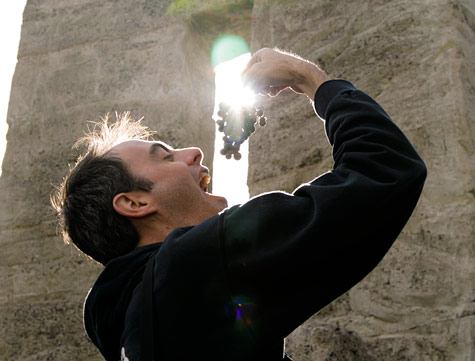Archive for the '2010 Garagistes' Category
Bottling the 2010s tomorrow
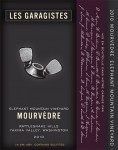
… including our first Mourvèdre (and Grenache, come to think of it)!
2010 Peugeot Blending Trials: the components
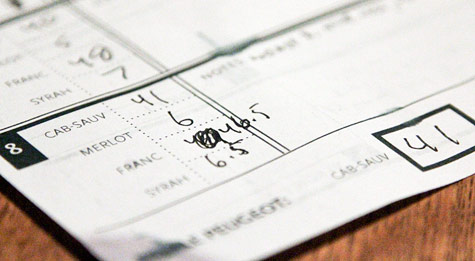
After a disciplined night of ascetic, scientific rigor (and, uh, drinking), we have an official blend for our 2010 Peugeot. Here’s the thrill-packed, edge-of-your-seats story of how it all went down, in the two phases we went through it: assess the components, then concoct the blend.
Boy, does that sound like exciting reading or what?! Yeah? Okay, then: life insurance paid up? Great. Grab your micrometer and follow me…
The Components
As always, we began by tasting the components, beginning with the Cab Sauv. Still very young — definitely in need of one more racking — but firm and substantial. As I’ve noted before, this vintage gave us a huge gift of higher acidity, in this case putting all the complex flavors (black raspberry, dark cherries, even a hint of peach) into high-def.
From the first taste, it was clear the Merlot — never a huge component of the Peugeot — was destined for an even smaller role than normal. While the basic outlines of its Merlot-ness were fine, leaving it too long in new half barrel had rendered it way too woody to use in any quantity. Again, I think a hard racking will help, but this probably won’t be Merlot’s year to snatch the Oscar, that’s for sure.
Then the Franc. Always the defining cornerstone of the Peugeot, and this year, it’s absolutely fantastic. A lovely, floral (from stem to blossom) nose, beautiful and elegant in the mouth, lingering lovingly over a long finish. Again, the acidity of the vintage plays right into the Franc’s hand, balancing the depth of fruit we get from Elephant Mountain Vineyard with a vividness that takes you out of your glass and into a summer field in the Loire.
Lastly, the Syrah. We discovered that some of the ethyl acetate that’s apparently plagued a lot of winemakers this year (think fingernail polish) had snuck back into the Syrah, so we’ll be carpet bombing this sucker with sulfite, and stat. But after the EA blew off, the wine’s true nature unfurled, with lovely deep fruit and a hint of licorice. Last year was the first time we added Syrah into the Peug, so provided we can 86 the EA, it’ll definitely have a cameo this year, too.
Next, the scintillating blending trials themselves…
No commentsViognier? Safely in bottle.
ikoni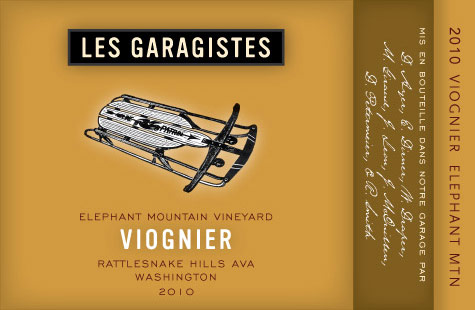 Eight cases plus eight bottles. 3.06 pH (hey, at least it’s better than 3.01, which it was a couple of weeks ago) — vivid! Lovely, floral nose, though probably goom-bah’d by a little too much oak at the moment. 25ppm sulfite at bottling. We’ll let it sleep until next summer and hope it unfurls.
Eight cases plus eight bottles. 3.06 pH (hey, at least it’s better than 3.01, which it was a couple of weeks ago) — vivid! Lovely, floral nose, though probably goom-bah’d by a little too much oak at the moment. 25ppm sulfite at bottling. We’ll let it sleep until next summer and hope it unfurls.
Update 2010: The Troubled Ones II
 Our Viognier may yet have a Hollywood ending. Our Rosé, well… by any other name, would taste as sweet…
Our Viognier may yet have a Hollywood ending. Our Rosé, well… by any other name, would taste as sweet…
Rosé
Our Rosé was a tank bleed (or “seignée”) of the Grenache right after it was crushed. I confess this one totally drank my lunch, tossing a number of problems at me I had no answers for. The biggest was thinking I was watching a nice, slow fermentation through the fall, then winter… then spring… when in fact primary fermentation had collapsed short of the goal and what I was actually seeing was malolactic fermentation (a secondary, bacteriological fermentation that changes malic acid into lactic acid). As a result, I didn’t realize this wine was “stuck” — not completely fermented and stalled in a sticky, quasi-alcoholic stasis — until a month or so ago.
Restarting a stuck ferment is notoriously hard, because you’re asking the yeast to start from a dead stop in an environment mostly toxic with alcohol (again, the ferment has nearly converted all the sugar to alcohol at this point, so the wine is pretty poisonous stuff as far as yeast is concerned). So I went through the laborious and time-consuming protocol recommended by the good folks at Scott Labs. It involves multiple nutrient additions over the course of a few days, then gradually adding waves of yeast over the course of an afternoon so they methodically gain confidence and territory without freaking out. In extreme cases, the protocol also calls for standing on one foot, baying at the moon, and whacking yourself with a switch.
Okay, those last three aren’t exactly in Scott Labs’ protocol, but I do think they helped in this case. One of the carboys actually finished, so now we need to decide if we should just blend the two together (the other is about 1% residual sugar), filter it, and call it a lesson learned; or figure out how to get the other one to finish.
Frankly, I’m ready to clear the decks, if only because the last thing I want to be doing in September as grapes arrive is pleading with a grumpy rosé. So I think we’ll probably just bottle it in the dark of some night and walk away, whistling innocently. It does still smell pretty decent behind all the yeast, so if we filter then blend the 1% and the nearly-none-percent carboys, we’ll have a wine that may be a tad sweet, but with luck, come off as “fruity” when chilled into restraint.
Here’s hoping…
No commentsUpdate 2010: The Troubled Ones
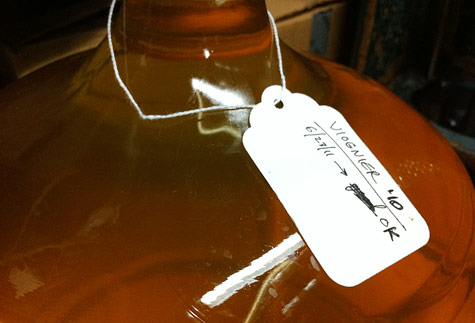 … and at last we come to the wines that haven’t exactly breezed through our underground lair. Not to say they might not be lovely some day, but for now: curse you, Bacchus!
… and at last we come to the wines that haven’t exactly breezed through our underground lair. Not to say they might not be lovely some day, but for now: curse you, Bacchus!
Today, our Viognier; next, the Rosé. Hmmm: they’re both white (or white-ish) wines. Just a coincidence, you say? Ah, gentle reader, that’s why we love you…
Viognier
This is our first year with this varietal, and we unwittingly made a huge tactical error right out of the gate: we didn’t have a herky enough press to really extract everything from this notoriously thick-skinned grape. That meant a much smaller yield than was our due, but it’s probably also why our wine is so acidic — just a hair over 3.0 pH: we’re working with just juice, not the (I’m guessing) riper compounds in the grape skins that resisted our press’ embrace.
So it’s a bit on the… refreshing side. “Crisp,” one might say. A “food wine,” as the wine industry spins its more bracing effluent. Maybe even: that “mom’s secret to whiter teeth” you’ve seen manically waving its hand in the back row of every web site, urging you to call on it.
Okay, enough ganging up on our gaunt Viognier. In its defense, it does still smell utterly lovely (peaches, pears, spice) — and the acidity is likely to preserve that nicely until its infrastructure begins to soften. So with luck, it’ll simply be a wine we’ll want to lay down for a year or so before enjoying.
And we haven’t just let it sit there, shivering in its acidity. To balance the low pH with more flavor and dimension, we’ve kept it on its lees, which we’ve been stirring once a week or so. That was an invaluable tip we got from Riesling specialist and all-around brilliant winemaker Matt Berson, of Love and Squalor Wines, and it really seems to have helped.
And not content to leave barely-well-enough alone, I also thought I’d try one last gambit to offset this wine’s high pitch: I added a touch of oak. Not much, and not for long, but yeah, maybe I do have some kind of death wish where whites are concerned. The idea was to add just enough to add some depth, but not enough to oak it into chardonnay — a fate worse than… brrrr, let’s change the subject!
But after just two weeks, I pulled a sample and — Yellow my Tail! — oak vanillin already seemed to have plowed over the fragrance! I immediately yanked it off the oak and the lees, and I’ve let it sit quietly to calm itself after its brief stroll walking the streets.
Then, this morning, I thiefed a sample: time to face the music. How badly had I F’d it up? But hmmm, you know what? The oak does seem to have descended into the wine, leaving the lovely Viognier fragrance intact but adding a bit of flesh to the wine — despite its still-bracing acidity. I’d been thinking we should fine this before bottling, but maybe we ought to let whatever particulate is still there continue its broadening effect and then just decant if there’s significant settling in the bottle.
Dare I say it? The yay may well be back in our Viognier! Time will tell…
No commentsUpdate 2010: The good
 Part Two of your 2010 update…
Part Two of your 2010 update…
Cabernet Sauvignon
The Cab in particular betrayed a self-destructive love of the EA (ethyl acetate) this year, so we’ve had to carpet bomb it with sulfite to jerk it back onto the straight and narrow. The good news is that it now appears to be EA-free, and as it emerges from beneath its heavy blanket of sulfite, it seems pretty nice, though still hard to get a clear sense of.
The EA problem also had at least one downstream consequence: some of the Cab is pretty dang oaky. That’s because the EA was particularly bad in our half barrel, so we (I think wisely) quarantined it until it was cured. But as a result, because that half barrel was new, the Cab therefore soaked up more new oak than we’d normally have liked.
I don’t think it’s a disaster by any means, but as a general rule, our philosophy is that oak should be like salt in food — if you notice it, you’ve put in too much. This year, whether we like it or not, we’ll see what happens when we’re forced to ignore that rule. The downside is oaky, woody vanillin potentially dominating; the upside, though, is more tannic backbone than we’re used to, so it’ll be very instructive to see how that unfolds over time. (How’s that for “[wine] glass half-full” take on things!?)
Merlot
I know: to sum up this wine’s life story as “it is what it is”, as I did earlier, is unfair and probably a little lazy, too — fashion has made looking down on Merlot way too easy. Nevertheless, this year’s Merlot is exactly that — Merlot — an amiable, good-natured wine that offers great companionship with little complication. We’ve lowered our harvest of this grape over the years, mostly because its part in the Peugeot blend has dropped over time, but I for one still enjoy it. There’s something comforting about a wine waiting for you when you get home on a weekday, wagging its tail with unconditional love. Who else is so glad to see you every time? Not that Cabernet, anyway — at least for now…
Next, the problem children…
No comments2010 Update: the pretty damn good
As promised in a few days ago, here’s the next installment of how our 2010 wines are faring. We begin with dessert: the wines that really seem like they’ll be excellent — assuming we let them make it to bottle and don’t gleefully guzzle them right now.
Cabernet Franc
We like to rack the Franc only two or three times over the year, supposing that minimal handling will help preserve its bewitching aroma. One of those rackings was a few weeks ago, and like a saucy mermaid, it beckoned us with a irresistible floral nose, and then lured us ever-further into the depths with succulent, floral fruit. Wow. Once again, this will be both hard to blend away and deservedly form the backbone of the Peugeot.
Syrah
I’ve opened two 2009 Syrahs in the last couple of weeks, and holy crap, this is the most adult wine I think we’ve ever made: deep and powerful but unmistakably syrah (vs. liquid oak with varietal flavoring, as many are). The 2010 looks to be a good follow-up, but with better acidity and rich, crisply-articulated fruit resonating through great depth. Awesome.
Grenache
This is the first year we’ve tried Grenache, and typical of our sober, judicious approach to winemaking, we blindly hurled ourselves over the edge, investing heavily. Luckily, it paid off: when we racked it about a month ago, its aroma was as bewitching as the Franc’s, but more luscious and Provençal-herby. Thankfully, we’ll have enough to bottle separately and cast in our first Côtes-du-Rhône blend this year. It’ll be one stunning leading lady in that road show.
Mourvedre
We pressed this varietal into service for the first time this year as the third leg of a Côtes-du-Rhône stool, but to our suprise, it stands on its own just fine, thank you. Inky dark, and redolent of pepper and roses. Holy moley.
Pinot Noir
After three vintages working with fruit from a highly reputed Dundee Hills vineyard, our Pinot this year is finally beautiful — if willowy. Since this varietal totally ate our lunch in the 90s, we’ve been pretty gun-shy about it: as with white wines, its essential delicacy means there are fewer places to hide crappy fruit or bad winemaking, both of which we had in ample supply back in the day. As a result, for the last few years we’ve only produced small batches as “side-bets” for the braver Garagistes.
This year, I’m proud to report, it looks like that bet will pay off, in part because we’re better winemakers, but more importantly, because we’re working with better fruit. Of course, 2010 was a lighter vintage in Oregon — no Parker wines this year without heavy manipulation — and our Pinot is no anomaly. But it’s not watery or bland. It’s just… elegant, with beautiful, focused fruit. We put a little oak on it a month ago (just a little), so by the time we bottle it in September, it ought to be really lovely.
No comments